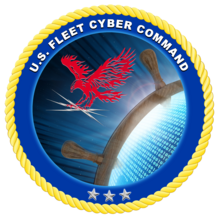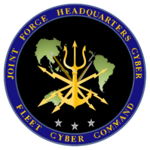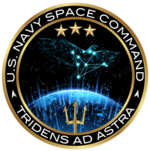U.S. Fleet Cyber Command
| U.S. Fleet Cyber Command | |
|---|---|
 Emblem of U.S. Fleet Cyber Command | |
| Active | 29 January 2010 |
| Country | |
| Branch | |
| Type | Naval operating force |
| Role | Cyber operations |
| Part of | |
| Garrison/HQ | Fort Meade, Maryland, U.S. |
| Website | fcc.navy.mil |
| Commanders | |
| Commander | VADM Craig A. Clapperton |
| Deputy Commander | CAPT Kurtis A. Mole |
| Command Master Chief | CMDCM John H. Walker Jr. |
| Insignia | |
| Seal of Joint Force Headquarters Cyber – Fleet Cyber Command |  |
| Seal of Navy Space Command |  |
The U.S. Fleet Cyber Command is an operating force of the United States Navy responsible for the Navy's information network operations, offensive and defensive cyber operations, space operations and signals intelligence. It was created in January 2010 "to deter and defeat aggression and to ensure freedom of action to achieve military objectives in and through cyberspace". U.S. Tenth Fleet was simultaneously reactivated as its force provider.[1] Since it was founded, the command has grown into an operational force composed of more than 16,000 active and reserve sailors and civilians organized into 27 active commands, 40 Cyber Mission Force units, and 27 reserve commands around the world.
Organization
[edit]U.S. Fleet Cyber Command serves as the Navy component command to U.S. Cyber Command, and the Navy's Service Cryptologic Component commander under the National Security Agency and Central Security Service. U.S. Fleet Cyber Command also reports directly to the Chief of Naval Operations as an Echelon II command and is responsible for Navy information network operations, offensive and defensive cyberspace operations, space operations and signals intelligence[2][1].
Headquartered at Fort George Meade, Maryland,[3] U.S. Fleet Cyber Command exercises operational control of globally-deployed Cyber Mission Forces (CMF) through a task force structure aligned to the U.S. Tenth Fleet. U.S. Fleet Cyber Command is also designated as the Joint Force Headquarters-Cyber to U.S. Pacific Command and U.S. Southern Command for the development, oversight, planning and execution of full spectrum cyber operations aligned with other traditional warfighting lines of operation.[4]

History
[edit]
U.S. Fleet Cyber Command's roots are in the namesake of its force provider, U.S. Tenth Fleet, which was organized in 1943 to coordinate the allied response to the German U-boat threat and ensure access to the shipping lanes of the Atlantic.
Today, U.S. Fleet Cyber Command and the modern U.S. Tenth Fleet ensure the Navy and the Nation have access to systems in the cyber domain.
The creation of U.S. Cyber Command and U.S. Fleet Cyber Command
[edit]Department of Defense cyber operations came together under a single organization on 1 October 2000, when U.S. Space Command (USSPACECOM) formally took control of the Department of Defense computer network attack activities from the Joint Staff. USSPACECOM was eventually dissolved and some its functions merged into the reorganized U.S. Strategic Command (STRATCOM) 1 October 2002.[5][6]
Navy Cyber operations were originally the responsibility of Naval Computer and Telecommunications Command, Naval Security Group and Naval Space Command, which were combined with 20 other commands into the Naval Network Warfare Command (NETWARCOM) in 2002 to unify network operations, offensive and defensive cyberspace operations, space operations and cryptologic/signals intelligences.
In 2005, with the alignment of Naval Security Group, NETWARCOM brought the former Naval Security Group Activities (NSGAs) under its umbrella and the mission of the command fundamentally changed, making it the Navy's lead command for information operations, networks and space.[7]
After extensive study, Secretary of Defense Robert Gates directed the creation of a new sub-unified command, U.S. Cyber Command (USCYBERCOM) on 12 November 2008, to operate under the authority of USSTRATCOM.
U.S. Fleet Cyber Command was officially created as the Navy component to U.S. Cyber Command on 29 January 2010.[8] Chief of Naval Operations Adm. Gary Roughead named Vice Adm. Bernard J. McCullough III as the commander of both U.S. Fleet Cyber Command and U.S. Tenth Fleet. All subsequent commanders have led U.S. Fleet Cyber Command and U.S. Tenth Fleet simultaneously.
In August 2017, President Donald J. Trump announced the elevation of USCYBERCOM from a sub-unified command under USSTRATCOM to a Unified Combatant Command responsible for cyberspace operations. U.S. Fleet Cyber Command remains the Navy service component to USCYBERCOM.[9]
In April 2019, Navy Space Command (NAVSPACECOM) was established as the service component of the U.S. Space Command, while being commanded by the head of Fleet Cyber Command. Since 2019 the Commander, Fleet Cyber Command, has also simultaneously been Commander, Navy Space Command, though the latter post was not formally established until January 2023.[10][11]
List of Commanders
[edit]| No. | Commanders | Term | |||
|---|---|---|---|---|---|
| Portrait | Name | Took office | Left office | Term length | |
| 1 | Vice Admiral Bernard J. McCullough III | December 2009 | 1 October 2011 | ~1 year and 10 months | |
| 2 | Vice Admiral Michael S. Rogers | 1 October 2011 | 3 March 2014 | 2 years, 153 days | |
| 3 | Vice Admiral Jan E. Tighe[12] | 2 April 2014 | 14 July 2016 | 2 years, 103 days | |
| 4 | Vice Admiral Michael M. Gilday[13] | 14 July 2016 | 18 June 2018 | 1 year, 339 days | |
| 5 | Vice Admiral Timothy J. White[14] | 18 June 2018 | 18 September 2020 | 2 years, 92 days | |
| 6 | Vice Admiral Ross A. Myers[15] | 18 September 2020 | 4 August 2022 | 1 year, 337 days | |
| 7 | Vice Admiral Craig A. Clapperton | 4 August 2022 | Incumbent | 2 years, 171 days | |
See also
[edit]References
[edit]- ^ Navy Stands Up Fleet Cyber Command, Reestablishes U.S. 10th Fleet, NNS100129-24
- ^ Affairs, This story was written by U.S. Fleet Cyber Command/U.S. 10th Fleet Public. "FCC/C10F Welcomes New Navy Cryptologic Office Executive Director". Retrieved 27 May 2018.
{{cite news}}: CS1 maint: numeric names: authors list (link) - ^ United States Navy, Chief of Naval Operations (23 July 2009). "Fleet Cyber Command/Commander Tenth Fleet Implementation Plan, (Memorandum)" (PDF). Retrieved 18 November 2009.
- ^ Gilday, Michael (13 March 2018). "Senate Testimony".
- ^ "Command History". www.cybercom.mil. Retrieved 2 June 2018.
- ^ Branch, This story was written by Navy Chief of Information Media Services. "Navy Establishes Naval Network Warfare Command". Retrieved 2 June 2018.
- ^ "Command History". www.public.navy.mil. Retrieved 2 June 2018.
- ^ "Navy Stands Up Fleet Cyber Command, Reestablishes U.S. 10th Fleet". U.S. Strategic Command. Retrieved 27 May 2018.
- ^ Gibbons-Neff, Thomas; Nakashima, Ellen (18 August 2017). "President Trump announces move to elevate Cyber Command". The Washington Post. ISSN 0190-8286. Retrieved 2 June 2018.
- ^ Sykes, William (18 September 2020). US Fleet Cyber Command, US Navy Space Command welcome new VADM. USSPACECOM. Retrieved 23 September 2023.
- ^ Sykes, William (1 January 2023). Formal Establishment of Commander, Space Command. Defense Visual Information Distribution Service. Retrieved 23 September 2023.
- ^ Cheryl K. Chumley (4 April 2014). "Vice Adm. Jan Tighe takes over as 'first female commander of a numbered fleet'". The Washington Times. Retrieved 27 May 2016.
- ^ Petty, Dan. "Navy.mil Leadership Biographies". www.navy.mil. Retrieved 16 November 2016.
- ^ "U.S. Fleet Cyber Command/10th Fleet Holds Change of Command".
- ^ "U.S. Navy Space Command Welcomes New VADM".


 French
French Deutsch
Deutsch

![Jan E. Tighe[12]](http://upload.wikimedia.org/wikipedia/commons/thumb/3/34/VICE_ADMIRAL_JAN_TIGHE.jpg/100px-VICE_ADMIRAL_JAN_TIGHE.jpg)
![Michael M. Gilday[13]](http://upload.wikimedia.org/wikipedia/commons/thumb/e/ef/VICE_ADMIRAL_MICHAEL_GILDAY.jpg/100px-VICE_ADMIRAL_MICHAEL_GILDAY.jpg)
![Timothy J. White[14]](http://upload.wikimedia.org/wikipedia/commons/thumb/1/11/Vice_Adm._Timothy_J._White.jpg/100px-Vice_Adm._Timothy_J._White.jpg)
![Ross A. Myers[15]](http://upload.wikimedia.org/wikipedia/commons/thumb/f/ff/VADM_Ross_A._Myers.jpg/100px-VADM_Ross_A._Myers.jpg)


